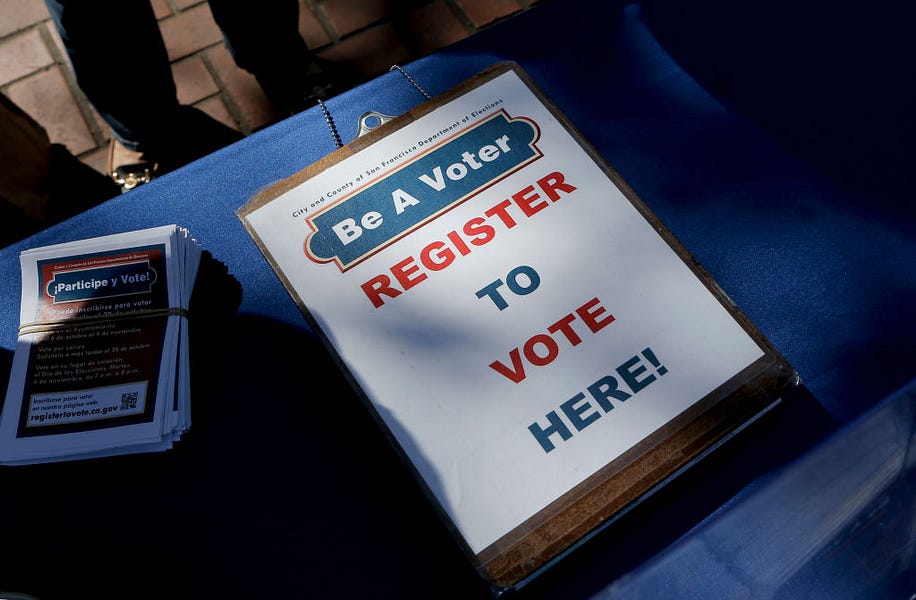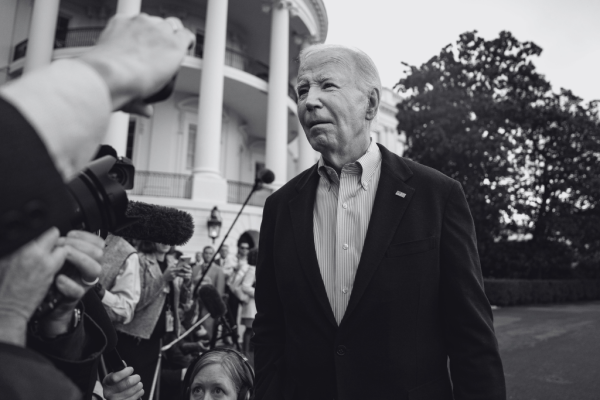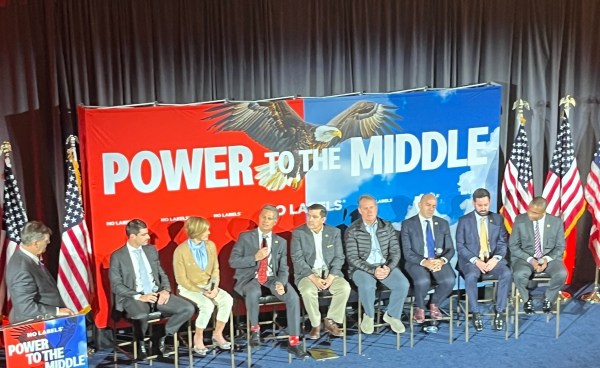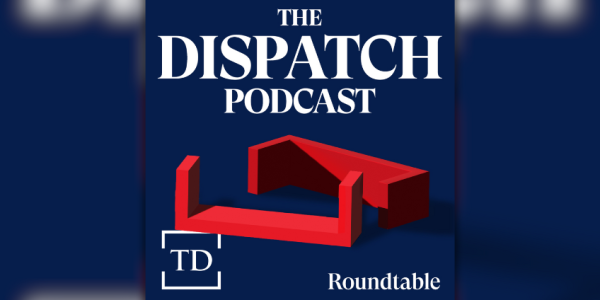You’ve Got to be Kidding Me
About That Education Gap
Race, gender … and now religion. Non-college educated minorities and women have been reliably shifting right, and we are seeing the same trend among Evangelical voters. What’s fascinating is that this isn’t an American phenomenon. It’s a Western democracy phenomenon, at least. Is it the rise of college graduates from a tiny minority to a sizable chunk of those populations? If so, why didn’t we see something similar around high school education between the Civil War and WWII when graduation rates soared from 1 percent to 78 percent? Is it something about the uneven impact of the 2008 recession? But why would education be a better predictor than income?
Let’s look at the shift among Evangelicals:
Small Dollar Problems
Axios reported that “Democrats across the 10 most competitive Senate races are out-raising Republicans by more than $75 million among small-dollar donors — those giving less than $200 — according to an Axios analysis of Federal Election Commission records.”
Democrats don’t actually have a meaningful money advantage in these races when you factor in larger dollar donors and super PACs (which is pretty meaningless at the margins regardless), but I’ve said before that small dollar donors can be a meaningful proxy for committed voters in a state. I’ve also said that such donors drive candidates to the loudest extremes of their parties because outrage and volume are the keys to raising money from the very small group of Americans who would consider giving $20 to a candidate.
So this means that Democratic candidates are banking progressive voters, but I’d bet they’re almost certainly moving left in the process, which means pushing away voters too.
How to Think About Voter Registration
It’s not unusual at this time of year to see headlines from one party or the other touting gains in voter registration as an indicator for a surge in voters for the fall. But reality is a little more complicated.
First, registration is often a lagging indicator. People change their voting behavior before they change their voter registration. A common scenario would be a registered Republican who voted for John McCain in 2008, Mitt Romney in 2012, Evan McMullin in 2016, and Joe Biden in 2020, but who only got around to changing his or her voter registration this year after accepting that they are no longer a Republican.
Case in point: Trump won six of the 19 states where there were more registered Democrats than Republicans. So if those people change their party registration sometime after 2016, it doesn’t mean Republicans got a new voter. It means Republicans already had that voter.
And lo and behold, that’s basically what we’re seeing. In Florida, “For the first time in the state’s modern history, the number of registered Republicans surpassed the number of registered Democrats” and Kentucky flipped just this month where “a Democratic registration lead of more than 185,000 in mid-2020 is now a Republican advantage of 2,491 registered voters — 1,612,060 to 1,609,569.” If anything, what we’re seeing in these states is the voter registration data come into line with electoral outcomes.
Second, not every state has party registration, so it’s often comparing apples to oranges when looking at larger trends. Only 31 states have party registration, and the 19 states that don’t are disproportionately Republican-leaning. So looking at raw numbers would show you that far more Americans are registered Democrats, but that’s meaningless when we consider that California and New York register by party but Texas, Ohio, and Georgia don’t. So while we can look at changes within those 31 states over time, it makes national trends harder to pluck out.
Pennsylvania is a perfect example of the important of party registration to those intra-state trends:
Republicans have posted significant registration gains in western Pennsylvania, once a hotbed of blue-collar Democrats. Since 2016, 4 counties in the region have flipped to the GOP, including Cambria (Johnstown) and Westmoreland, a populous county outside Pittsburgh.
Meanwhile, Democrats have expanded their domination of the once-Republican Philadelphia suburbs. With the registration advantage in Chester County switching during the “Trump era” from Republican to Democratic, the latter now holds the upper hand in party registration in all 4 suburban counties. The Democrats’ greatest advantage is in Montgomery County, where this summer there are now nearly 100,000 more registered Democrats than Republicans. It is a far cry from a generation ago, when Montgomery was the crown jewel of the state Republican Party.
Given the caveats above, here’s the bottom line from UVA’s Center for Politics: “Republicans have made gains over Democrats in 19 states since summer 2018, when we last looked at these trends, while Democrats have made gains over Republicans in 12 states and the District of Columbia.” A mixed bag. And that’s about what I’d expect to see as the two parties realign with education replacing race in some of these states are a better predictor of voter behavior.
But also check out where the changes are happening. Republicans are cutting into Democratic registration advantages in battleground states like Nevada, Pennsylvania, and Iowa. Democrats, on the other hand, are running up the score in states they were already winning like New York, New Jersey, Delaware, Maryland, Maine, Oregon, Colorado. In California, for example, Democrats went from an advantage of 3.7 million voters over Republicans to 5 million in the past six years. That’s interesting on its own—but tells us next to nothing about how Democrats may do in the midterms or in 2024.
And that leaves us with these parting thoughts on voter registration: It’s very helpful for political scientists to study voter trends over decades. It’s not that helpful for campaign operatives who want to know who is going to win in a few months.
One Primary, Three Variations on Trumpism
The Republican Senate slate has mostly taken shape, but there are still a few outstanding races—including two significant primaries a week from today in Missouri and Arizona. On the site today, Andrew has a new report up on the former race—where three Republican contenders, former Gov. Eric Greitens, state Attorney General Eric Schmitt, and U.S. Rep. Vicky Hartzler are all considered viable possibilities for the nomination. The three are running on different iterations of the brew of social and cultural positions that we’ve come to call “Trumpism”—Greitens, who resigned from office in scandal four years ago, has embraced the “enemy of my enemy” negative ideology of the MAGA id, Schmitt has campaigned on his hard-edged record of lawsuit after lawsuit against the Biden administration, and Hartzler has done her best to bridge the gap between her own religious-right style and the “America in crisis” energy of today’s GOP.
All three share one thing in common: an avowed skepticism about the results of the 2020 election. They have each leaned in to different degrees.It’s a centerpiece campaign issue for Greitens, who screens stolen-election movies at his campaign stops, while “election integrity” is a laundry list issue for Schmitt. Hartzler rarely talks about 2020 on the stump, but even she hastens to add that the question of fraud in 2020 remains “very, very, very concerning” and that “I don’t think we’ll ever really know” whether Biden’s win was legit, “because there were so many discrepancies.”
The latest polling has Schmitt surging and Greitens sinking—more so now even than when we published the piece this morning. It was only about an hour later that Emerson College released its latest nonpartisan poll, which put Schmitt at 39 percent support—up from 20 in Emerson’s last poll in early June. Hartzler clocked in at 24 percent, up from 16 percent, and Greitens sagged from 26 points in June down to 19 points.
Did 2012 Break America?
Dan McLaughlin over at National Review Online makes a compelling case that “If 2016 exposed the destruction of the post-war American political order, 2012 was the election that broke it.” Here’s one part I found particularly insightful:
Stray voltage won. Worse, it was overinterpreted. Exit polls assumed that 23 percent of voters were white, over age 45, and without a college degree; census and voter-file data found the real number was 29 or 30 percent, a difference of 10 million voters. That means exit polls overstated Obama’s reliance on running up his margins, and understated his support with working-class white voters in the Midwest who saw Romney as an avatar of bloodless global capitalism. Black turnout was high, but a Brookings Institution analysis erroneously claimed that it was higher than white turnout and solely responsible for Obama’s victory. The myths traveled farther than the facts.
Obama’s dominance among non-white voters seemed to vindicate the most reductionist reading of the Ruy Teixeira–John Judis thesis of an “emerging Democratic majority.” Liberal pundits eagerly adopted a triumphalist framework: Republicans represented an inevitably shrinking minority, to be replaced by the growing Hispanic population. The GOP would be permanently locked out of the presidency by the Democratic “blue wall” of Pennsylvania, Michigan, Wisconsin, Ohio, and Iowa. Republican victories in 2010, and later in 2014, were written off by the ascendant Obama coalition as artifacts of lower midterm turnout. Forgetting Obama’s appeals to anti-globalist economic nationalism, Democrats pivoted further to ally their non-white voter base with college-educated white professionals along cultural lines.
The resulting political theory was that Democrats no longer needed working-class white people or the political center. In this telling, only the Democrats’ presidential electorate was a legitimate expression of the popular will. Even in 2012, they refused to accept the verdict of Scott Walker’s 2010 election as Wisconsin governor and launched a recall that was roundly rejected by the voters in June, making the college-dropout Walker the first American governor to survive such an effort….
In 2013, Senate majority leader Harry Reid abolished the filibuster for appellate judges to get Obama appointees on the D.C. Circuit. Mitch McConnell warned that he would regret this, and retaliated in 2016 by blocking Obama’s nomination of Merrick Garland to the Supreme Court. Reid’s move made no sense if a Republican might return soon to the White House — but the theory of an inevitable demographic tide seduced him into ignoring that risk. In 2016, Harvard Law professor Mark Tushnet wrote that liberal jurists should rule as if “the culture wars are over; they lost, we won.” Three Republican appointments later, the Supreme Court overturned Roe v. Wade.
What, Exactly, Are Democrats Running On?
Just when Democrats thought they’d had enough problems ahead of the midterms, recent surveys indicate that most voters aren’t even aware of one of the few legislative policy wins Biden racked up during his first year in office. From Politico’s Sarah Ferris: “Most people are big fans of President Joe Biden’s $550 billion infrastructure bill — except they don’t know it’s actually been passed. That’s the conclusion of new polling that promises to further rattle the Democratic Party. Eight months after Congress cleared the landmark legislation to overhaul the nation’s roads, bridges, rails and broadband, only 24 percent of voters are aware it’s now a law, according to new polling by the center-left think tank Third Way and Impact Research that was shared first with POLITICO.”
Speaking of which… Audrey Fahlberg and Price St. Clair published a story last week exploring how Joe Biden’s low favorability ratings are weighing on Democrats ahead of the midterms. Here’s a sneak peak:
Democrats’ Elephant in the Room
Now less than four months until the midterm elections, President Joe Biden’s historically low approval ratings are ratcheting up political pressures on fellow Democrats, a growing number of whom are voicing their concerns.
According to FiveThirtyEight’s Geoffrey Skelley, Biden’s “approval rating of 39 percent is now the worst of any elected president at this point in his presidency since the end of World War II.” A recent New York Times/Siena College poll had his approval rating among registered voters even lower, at an eye-popping 33 percent.
It’s no wonder then that many Democrats running competitive races this cycle are trying to keep Biden off of their campaign trails. “I really don’t want anyone to join me, like this is my race,” Democratic Rep. Tim Ryan, who is battling Republican J.D. Vance in Ohio’s U.S. Senate contest, said in an interview Tuesday when asked whether he hopes Biden will stump alongside him. “I’m the face of this. It’s my voice, my record, and my issues, so we’re not really asking too many people to come in.”
Click here to read the rest.









Please note that we at The Dispatch hold ourselves, our work, and our commenters to a higher standard than other places on the internet. We welcome comments that foster genuine debate or discussion—including comments critical of us or our work—but responses that include ad hominem attacks on fellow Dispatch members or are intended to stoke fear and anger may be moderated.
You are currently using a limited time guest pass and do not have access to commenting. Consider subscribing to join the conversation.
With your membership, you only have the ability to comment on The Morning Dispatch articles. Consider upgrading to join the conversation everywhere.